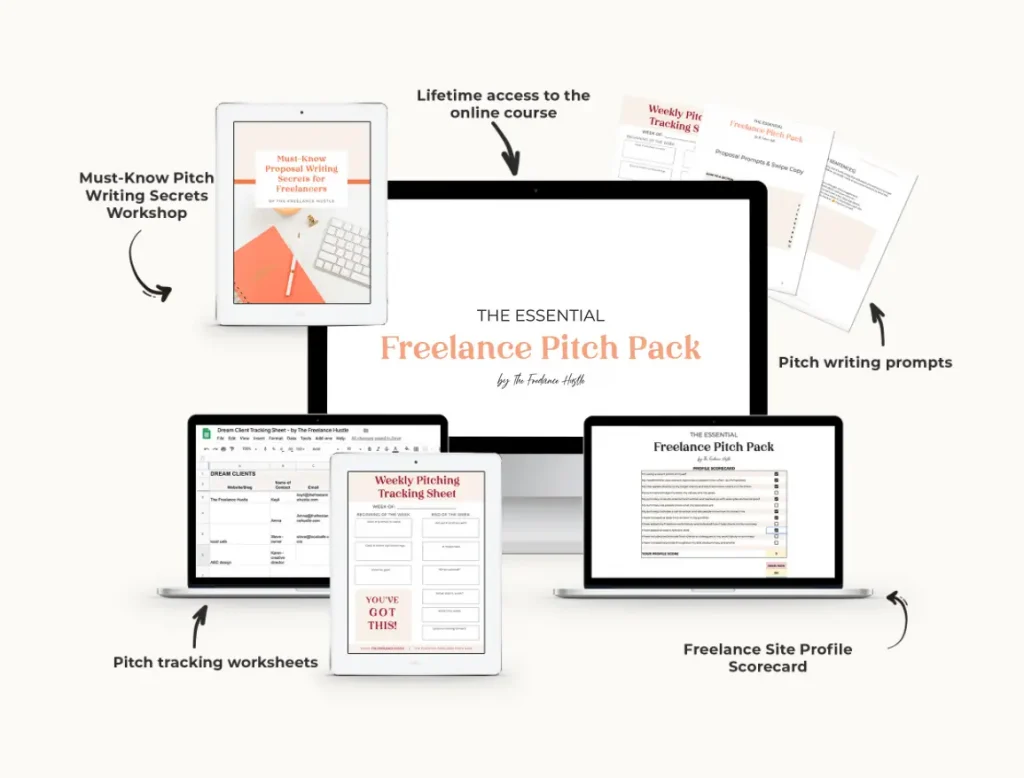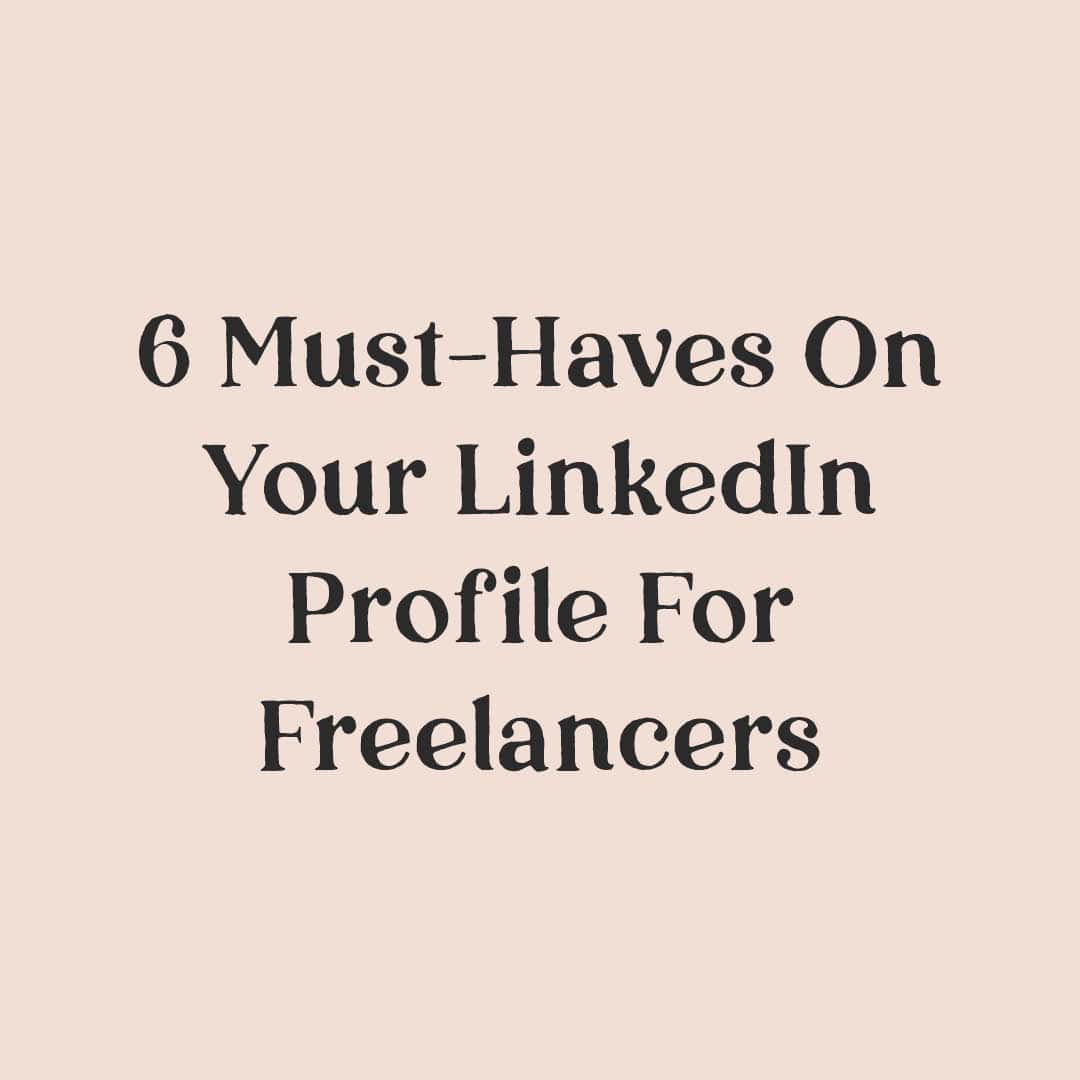How To Write Your Freelancer About Page
One of the most important pages on your freelance website is your About page.
When a new reader or potential client finds their way to your site, they’re going to make a stop at your about page. This is a chance to form a deeper connection with that reader, and keep them from clicking away from your site and never returning.
About pages are valuable real estate on your website – but most people completely waste them by writing things their reader doesn’t care about… like an entire autobiography.
So the first thing to keep in mind when creating your about page:

Trying to land more clients and projects?
You need the Essential Pitch Pack!
YES PLEASE »
Your about page isn’t really about you. It’s about your target clients.
This page is your chance to tell your story, and form a more personal connection with potential clients and readers.
And while it’s not meant to be a repeat of your portfolio or a copy of your LinkedIn profile, it does need to present you as an expert. After all, the point of your freelance website is to get hired by clients, right?
So how do you go about personally connecting with your potential clients, and highlighting that you’re an expert, all in one page? Let’s dive in.
5 Things To Include On Your Freelancer About Page

1. What’s in it for them
When a new reader lands on your about page, there’s a few things they want to know:
- What can they expect to learn from you?
- How can you help them?
- Why should they stick around and keep reading?
So right off the top, answer these questions and tell them what’s in it for them if they stick around your site, join your community, or hire you.
Hook your readers right away with a headline and a paragraph or two that speaks to them deeply about their biggest frustrations or desires.
Create a headline to either call out their biggest pain point or frustration in their business, or go the other way and try to tap into what they desire most.

Check out this example from Paige Brunton. She isn’t talking about herself at all here. She’s getting her reader’s attention by saying exactly what they’re thinking right now.
Tap into the emotion your ideal client’s and readers are feeling so you’re headline connects with them right away, pulls them in, and keeps them on the page.
2. Introduce yourself
After you’ve hooked the reader by talking about their biggest desire or problem, it’s time to introduce yourself as the hero they need.
This isn’t where you tell your whole life story (spoiler: your freelance website isn’t for that!). Keep your intro relevant to the pain point or desire you just brought up. Tell the reader why they should hire you to help them.
Highlight your credentials or accomplishments – not in a way that you’re bragging but in a way that tells your clients they can trust you to get them results
How do you do that?
- talk about your experience helping clients, employers, or friends and family with this problem
- share your relevant credentials, education or even awards
- talk about why started your business, why you got into this field, or why you’re so passionate about what you do
- share links to your best work, your guest posts, or media coverage (like podcast interviews!)
This introduction to you and your story is all about building trust. Focus on the things that get your clients to trust you.

Kelsey from Paper & Oats shares a bit about her working style, then highlights her guest posts and podcast interviews.
3. Build trust with social proof
You’ve established some trust with your reader about your experience and capabilities as a freelancer, now it’s time to take it a step further.
Nothing builds trust and locks it in like social proof – aka testimonials and recommendations.
This is why we rely so much on Amazon reviews and star ratings on Uber Eats! We trust the opinions of others, even if we don’t know them. 🤷♀️
Use a few testimonials or recommendations here. Bonus points for including pictures of your client with the testimonial (a picture of a real person builds even more trust).
4. Get personal
At this point you’ve gotten your reader to trust you. Now you want them to feel like they know and like you, too. You’re trying to create a deeper connection with them so they can picture themselves working with you.
Stories are the way to creating that deeper connection.
Share some fun or unique details about yourself that your ideal client would find interesting. If you have a decent idea of who your ideal client is, you can make an educated guess about the things they will or will not resonate with. For example, if your ideal client is a 45-year-old male CEO of a software company, he probably isn’t going to relate to your jewelry making hobby. But if your ideal client is a single 30-something female solopreneur and aspiring digital nomad, she’s definitely going to relate to your travel bucket list.
Not everything you share about yourself has to be a common interest or trait with the reader. But the point here is to get your client nodding in agreement, saying “oh me too!” and thinking to themselves “I really want to meet them.”
If you’re stumped about what to say, just try to think about what you would tell them over a coffee or a beer, not a formal interview.

Check out how Hilary Rushford of Dean Street Society uses a collage of her favourite things so readers get to know her personality.
This is your chance to show off what makes you YOU. Get creative.
5. Keep the relationship going
You’ve put in all this work getting your reader to know, like, and trust you. Now the last thing you want is for them to leave without taking any action.
You’re basically building a relationship here. Now’s the time to exchange numbers so you can see each other again.
You can get readers to connect with you and keep your virtual flames alive by adding CTAs (call-to-action). Your about page should have at least one CTA, but you can have several.
Here are a few CTA ideas to include:
- Book a consultation call – get your potential client in a consultation call to talk about their project. If you’re trying to get clients this is the most important CTA your about page can have.
- Get on your email list – offer up your freebie or lead magnet to get your new reader on your email list, STAT. This way you can stay in touch and send them more information about your awesome services with your email onboarding sequence.
- Connect on social – share your active social media channels and invite them to send you a message there. If you’re always on Instagram, showcase your channel, and invite them to follow you and connect there. This will help keep you in their mind when you hopefully pop up in their feed.

Jenna Kutcher covers all of these CTAs here. She’s linking to her most important blog posts (to keep readers on her site), links to all her social channels and highlights Instagram where she is most active, and she has a big CTA to download a freebie and get on her mailing list.
Use one or all three of these CTAs. The point is to make it as easy as possible for readers to stay in the loop with you.
When you create your freelancer about page with your ideal client in mind, you’ll be able to write a compelling story that hooks them from the start and makes them want to get to know you more.
Need help planning out your killer website? Grab the free guide!
[et_bloom_inline optin_id=”optin_11″]
Pin these for later! 👇







